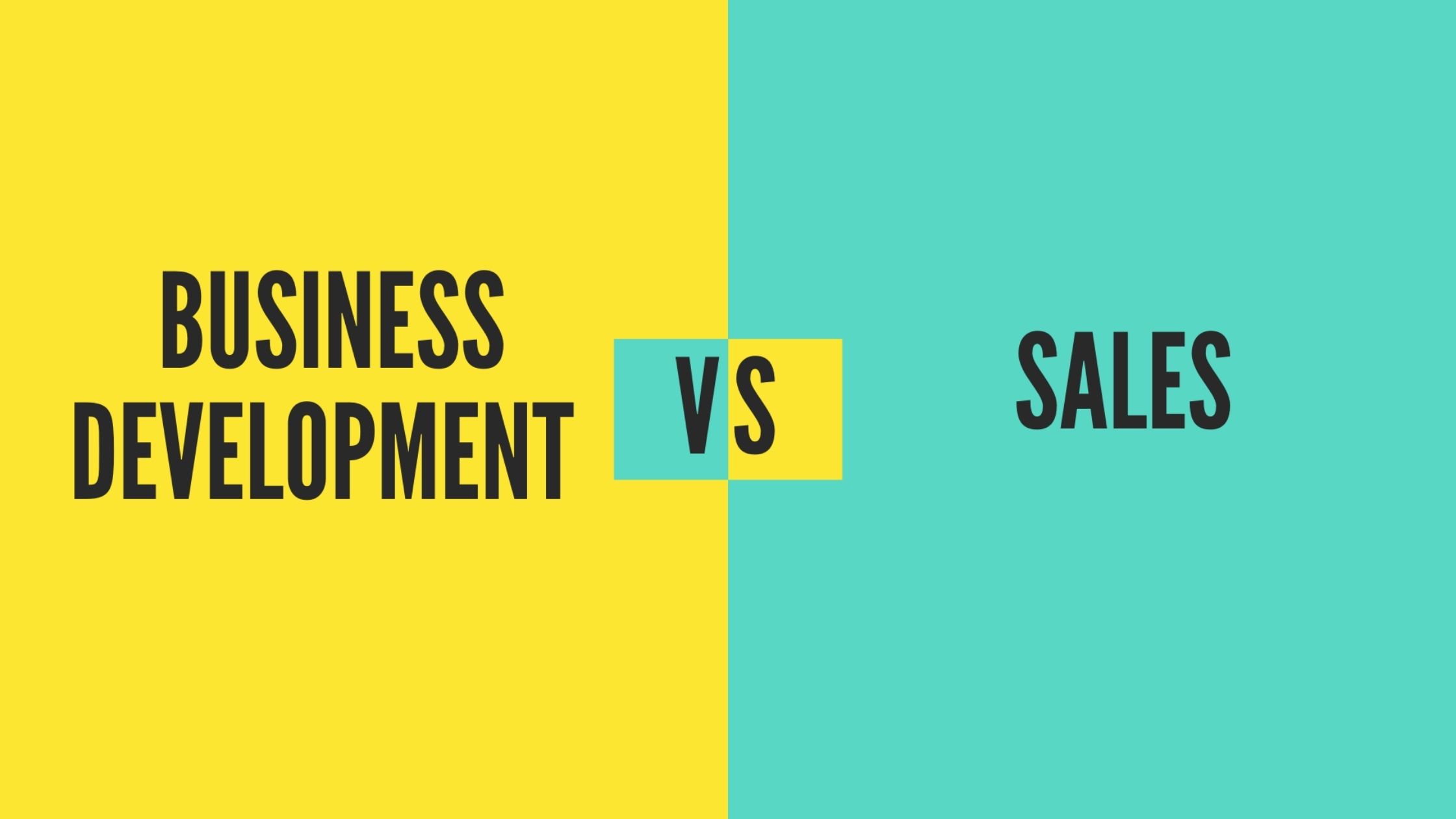While the terms marketing and business development may be used interchangeably, marketing and business development are actually two very different approaches to how you drum up new business.
Marketers, salespeople, and your business development team all have objectives such as: generate new leads, build strategic relationships, improve the sales process, and ultimately get new clients.
When it comes to driving revenue and growth sales, business development and marketing are three of the most critical functions within an organization. However, the distinctions between these roles are often blurred. In this article, we’ll clearly define these functions, explain how they differ, and illustrate why they must work together seamlessly for maximum business impact.
Defining Sales, Business Development, and Marketing
Sales focuses on converting leads into paying customers. The sales team engages directly with prospects to understand their needs, match those needs with products/services negotiate contracts, and close deals. Salespeople have quantitative targets and quotas they must hit.
Business development identifies, qualifies, and passes sales-ready leads to the sales team. The business development team performs research to identify prospects, engages in networking and outreach to connect with them, and nurtures relationships to determine fit.
Marketing attracts and nurtures a pool of potential customers through activities like content creation, events, advertising, and more. The marketing team focuses on positioning the brand in the marketplace and generating interest.
While sales, business development, and marketing play different roles, they share the aligned goal of driving revenue.
Key Differences Between the Functions
Below we summarize some of the main differences between sales, business development, and marketing
-
Mindset: Sales has a transactional mindset focused on closing deals. Marketing has a long-term brand building mindset. Business development connects the two with a partnership focused mindset.
-
Type of Activities: Sales activities include calls, demos, negotiating. Marketing activities include content creation, campaign management, event planning. Business development activities include research, networking, partnership development.
-
Goals and Metrics: Sales goals include quantitative targets like closed deals, account expansion, revenue generation. Marketing goals include brand awareness, traffic, leads generated. Business development goals include quality partnerships and sales-ready opportunities sourced.
-
Buyer Engagement: Sales has direct engagement throughout the sales cycle. Marketing engagement is largely indirect touchpoints. Business development engages during the top-of-funnel nurturing and lead qualification process.
-
Compensation: Sales is heavily commission-based. Marketing and business development have a mix of base salary plus performance incentives.
While their day-to-day tactical activities differ significantly, sales, marketing and business development all play important strategic roles in generating pipeline and revenue.
The Crucial Link Between Sales, Marketing and Business Development
For maximum effectiveness, seamless alignment between sales, marketing and business development is crucial. Here’s an overview of how the departments work together:
- Marketing generates interest and passes leads.
- Business development qualifies and nurtures the leads, passing sales-ready opportunities to sales.
- Sales closes the deals, with support from marketing and business development as needed.
This alignment ensures prospects experience a streamlined, consistent journey from initial interest all the way through to becoming a customer.
To enable this alignment, here are some best practices:
-
Shared goals and metrics: Have shared KPIs across functions related to pipeline generation, velocity, and revenue. This builds a spirit of unified purpose.
-
Ongoing communication: Maintain open communication channels through meetings, reports, shared CRM and documented processes. This minimizes silos.
-
Cross-functional collaboration: Bring sales, marketing and business development together for joint strategizing, content development, and campaign execution.
-
Unified messaging: Make sure messaging and positioning is tailored but consistent across the funnel.
-
Defined handoffs: Clearly document criteria for lead qualification and escalation between functions.
-
Shared tools and systems: Use tools like CRMs that enhance transparency between teams.
Sales, Business Development, and Marketing Job Titles
Below are some common job titles within sales, business development, and marketing functions:
Sales Titles
- Sales Representative/Sales Rep
- Account Executive
- Sales Manager
- VP of Sales
- Chief Revenue Officer
Business Development Titles
- Business Development Representative
- Business Development Manager
- VP of Business Development
Marketing Titles
- Marketing Manager
- Marketing Specialist
- Content Marketing Manager
- Social Media Manager
- VP of Marketing
- Chief Marketing Officer
While titles help indicate roles, remember that alignment of mindset and goals across functions is much more important than departmental silos.
Wrapping Up
Sales, business development and marketing have unique but tightly linked roles within an organization’s revenue engine. When properly aligned, they work in harmony to attract prospects, develop relationships, close deals, and drive growth. Misalignment leads to fractured handoffs, wasted efforts, and lost revenue.
As your company scales, consciously strengthening the collaboration across these functions will maximize their strategic impact. With seamless teamwork, you’ll be well positioned to hit your growth goals.

What is the difference between Marketing and Business Development?
Marketing’s focus is on your consumer, their journey from awareness to loyalty, and the strategies and tactics that are employed to reach that loyalty stage.
Business development, however, focuses on the processes and tasks that will grow revenue opportunities.

Marketing is all about your target audience: understanding who they are, what they want, and how you can communicate with them that your product or service has what they are looking for.
The role of marketing is to identify consumers who need the product or service that their company offers. From there, strategic marketing efforts will continue to communicate with those customers, building a relationship via sophisticated marketing plans that will eventually lead to the consumer buying the product or service.
Other roles that marketing provides include:
- Identifying consumer needs
- Developing marketing strategies
- Showcasing how their product will address or satisfy those needs
- Aid the packaging and product design
- Highlight the unique value proposition
- Consumer communication
- Initial customer experience
- … and more!
Members of the marketing department will often report to the CMO, or Chief Marketing Officer, to ensure that their activities are aiding in overall business development.
Role of Business Development
The business development process focuses on business growth.
There may be debate about what business development is exactly but let’s use the definition of it being generating new business.
Someone who works in business development will participate in the activities, ideas, and initiatives that will improve the business.
A few key areas involved in business development include:
- Sales growth
- Business expansion
- Attend trade shows
- Strategic business partnerships
- Overall business profitability
- Evaluation of competitor developments
- New opportunities in the market or new markets
A business development manager will report to the CMO or business owner to ensure their strategy and objectives align with overall company goals.
Difference between Sales, Marketing, and Business Development | Corpbiz
What is the difference between sales marketing & business development?
There are key differences between these disciplines, primarily in their respective approaches. Here are some of the key differences between sales, marketing and business development: The sales department typically focuses on short-term results and what the customer or client can buy from the business straightaway.
What is the difference between sales development and business development?
The sales development department focuses on the products the company can deliver to the customer immediately. The business development department focuses on the technology available to develop new solutions for the customer. The sales department in the tool company example would focus on getting the current product line out to stores and consumers.
What is the difference between business development and marketing?
The focus of business development is on the long-term outlook of the business itself. Sales similarly concentrate on the company’s needs, but it has a much shorter-term outlook. In contrast, marketing focuses on the customer’s needs in the target market and those are the primary motivator.
How do sales & business development & marketing work together?
The individual departments of sales, business development and marketing integrate to target customers from different angles. Each uses an approach that fits the goal of the department and works in tandem with the other departments for a complete customer experience.